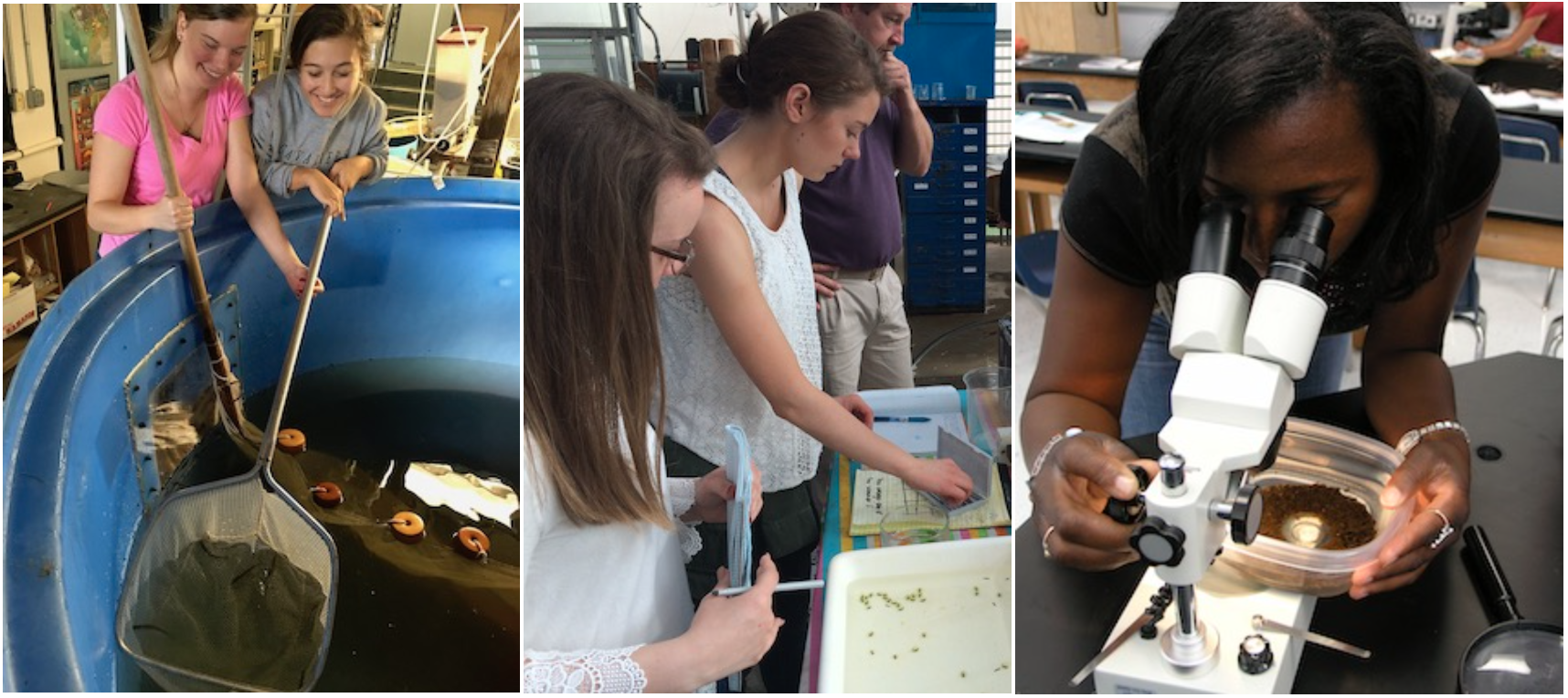Knauss legislative fellowships in Congress help build careers — and they're fun and educational. See our video and fact sheet for details.
K-12 Resources

Explore instructional strategies about marine and coastal science in the Chesapeake Bay region. Because coastal science is interdisciplinary, these resources are a tool for teaching about core issues in the sciences. Teachers and administrators in Maryland helped to develop these lessons and test them in classrooms using a project-based learning model.
Featured Programs
Aquaculture in Action
Teachers learn to construct recirculating aquaculture systems designed for the classroom. Through partnerships and funded programs, they receive live fish, tanks, filtration devices, and water quality monitoring systems. Students raise native species of fish supplied by the Maryland Department of Natural Resources. They learn about water quality monitoring, fish biology, and how to manage and design recirculating aquaculture systems. Maryland Sea Grant offers professional development workshops for teachers on how to set up and maintain recirculating aquaculture systems and use aquaculture as a tool for teaching science.
Grades: 9-12
Instructional Strategy: Interactive
Biofilms and Biodiversity
Metal discs are placed in the water in Baltimore’s Inner Harbor, where they develop biofilms (communities of microorganisms) and attract invertebrates that colonize the surface. The discs are collected and delivered to classrooms, where students observe the biofilm communities under microscopes and learn to calculate measures of biodiversity. Students also learn about plastic pollution by isolating and observing microplastics found on the discs, using methods developed with classroom teachers.
Grades: 6-12
Instructional Strategy: Interactive
Eastern Oyster
Students study or observe oyster biology, external and internal anatomy (structure and function), immune system function, and suspension feeding. Three activities use live oysters.
Grades: 6-12
Instructional Strategy: Interactive, 5E
Spotted Salamander
How does climate change impact spotted salamanders? Students analyze weather data, use models to locate possible vernal pools, and make predictions about salamander migration. They also learn about the spotted salamander's lifecycle and symbiotic relationship with algae, a one-of-a-kind relationship between an algal cell and a vertebrate animal.
Grades: 6-12
Instructional Strategy: Interactive, 5E
More Programs
American Chestnut
In 1904, the chestnut blight fungus (Chryphonectria parasitica) spread through the forests of the eastern United States, wiping out nearly all American chestnuts (Castanea dentata). In these lessons, students learn about taxonomy by identifying different chestnut tree species. They study the impact of invasive species through the story of the American chestnut.
Grades: 6-12
Instructional Strategy: 5E
The Case of the Disappearing Blue Crab
Students learn about the blue crab (Callinectes sapidus) and Hematodinium dinoflagellate spp. They explore the blue crab's population decline, graph data, and use gel electrophoresis to test for the presence of Hematodinium DNA in mock samples of crab hemolymph.
Grades: 9-12
Instructional Strategy: 5E
The Effect of Tides and Elevation on Wetland Plants
Studying a freshwater tidal marsh, students learn how tides can impact shoreline plant communities. Before completing these lessons, students should understand basic tidal concepts, such as the cause of tides, the tide cycle, spring tides, and neap tides.
Grades: 6-12
Instructional Strategy: 5E
Fish Oil, Really?
Fish oil comes from fatty fish like salmon, mackerel, and sardines. It contains omega-3 fatty acids. In these lessons, students learn about fats derived from plants and animals and their basic physical properties. They gain an understanding of the marine food chain and the production of omega-3 fatty acids.
Grades: 6-12
Instructional Strategy: 5E
Oyster Behavior in the Larval Stage
Though microscopic in size, oyster larvae move in complex ways. In these lessons, students use research videos to study oysters in their first few weeks of life. They identify behavior patterns, calculate swimming speeds, and ask whether varying conditions, like temperature and salinity, affect oyster behavior.
Grades: 7-12
Instructional Strategy: 5E
Zebrafish as a Model for Muscle Development
Using zebrafish as a model, students learn about muscle development and protein synthesis. Then, they apply the scientific method to design their own experiment.
Grades: 6-12
Instructional Strategy: 5E
Maryland Sea Grant Staff
.jpg)
For more information, contact Adam Frederick at frederic@mdsg.umd.edu



